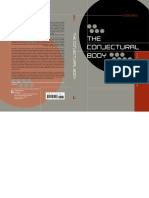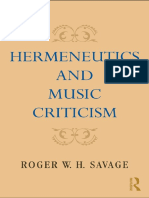Final Musicology
Final Musicology
Uploaded by
Brodie McCashCopyright:
Available Formats
Final Musicology
Final Musicology
Uploaded by
Brodie McCashOriginal Description:
Copyright
Available Formats
Share this document
Did you find this document useful?
Is this content inappropriate?
Copyright:
Available Formats
Final Musicology
Final Musicology
Uploaded by
Brodie McCashCopyright:
Available Formats
To what extent does music sound like the social groups who identify closely with it? (E.g.
Does it mirror those who created it? Can music mirror or reflect social structures?). Discuss
with reference to sources and examples.
Music has always been a part of life; from the first sounds to be produced vocally by
Neanderthals to the instruments and synthesisers we have now, and has always been used
as a way to define class and social groups. Throughout history music has been seen as
controversial and at times, quite specific and unique to certain social groups such as the
African slaves who had brought their songs over to North America, eventually developing
into the blues. Yet, even after the slave trade, the blues were and occasionally still are
associated to the lower class. 1 I feel it is important not to distance yourself from social class
when discussing social groups, as these are often closely related. Despite these different
social group and classes, there will always be an overlap in musical interest. This essay will
discuss both music and its effect on social structure and movement through political and
other means, along with the representation of music within societal groups and classes.
Music has always been involved in historical events also, from Beethovens Eroica
Symphony and its links to the Napoleonic period, or his Fifth Symphony, and its link to the
British soldiers during WW2. Like at this time, music acts as a way to express emotions and
the views of our time, which is the main reason different music is identified with different
social groups. Music also created great divides such as seen and heard in religious and non-
religious groups. Sociologists such as Ron Eyerman and Andrew Jamison believe that by
combining culture and politics, social movements serve to reconstitute both, providing a
broader political and historical culture traditions, music, and artistic expression. This
shows that they also believe that social structure can affect expressionistic values such as
2
music when there is political and cultural influence. Composers in the early to mid-20th
Century had used music to convey their opinions and beliefs about the political issues of
their time. Khachaturians ballet, Spartacus, had been used in a very political manner. The
story of Spartacus is based upon a Roman slave revolt that ended in Spartacus downfall
after two years when Marcus Licinius Crassus kills him. The remaining rebels were crucified
along the Appian Way. The Soviet Union and its authorities allowed the ballet to be written
and performed, as they had seen it as a hidden message about the Russian people
overthrowing the tsars in the early 1900s. The communists could also see it in the mid-20 th
1 All About Jazz, A Brief History of the Blues, http://www.allaboutjazz.com/a-brief-history-of-
the-blues-by-ed-kopp.php (Authored 2005, Accessed 2nd May 2016)
2 Ron Eyerman and Andrew Jamison, Music and Social Movements: Mobilizing Traditions in the
Twentieth Century (Cambridge, 1998), p.7-11
Student ID: 51443432 Page 1 of 7
Century as a message about the communists rebelling against the Soviet leaders of the
time. Khachaturian has written that whilst he tried to capture the atmosphere of ancient
Rome in order to bring to life the images of the remote past, I never ceased to feel the
spiritual affinity of Spartacus to our own time. This shows that the music was a reflection on
the state of his country at the time due to the political groups within the country. What side
3
he was writing this quote and trying to convey through his music is an uncertainty. This
helps to show that there has been quite a strong link between music and social parties and
groups within the given political era at least.
Even in todays society, political groups who have power have a massive impact on the
types of music that are available and accessible to the public. One of the largest influences
is in Afghanistan, especially in areas under Taliban rule, approximately 398 districts. 4These
dictations of music are extremely precise, and have an effect on the availability of genres to
the citizens in the districts. The Taliban only permits music that are Taliban chants and
some religious songs. The main reasons for the Talibans ban on most music come from the
refugee camps from Pakistan and Iran where music had been completely forbidden. Come
1996, there had been a complete ban in music and other audio sources in these regions,
with all musical instruments and other sources of visual and audio media such as, cassettes,
and TVs being seized and often burned in public displays. Within the Taliban controlled
areas, there is still heavy execution of this censorship. An Afghan man had told a reporter
that if there is a wedding happening at someones house, where music is being played and a
Taliban walks by, it would be normal practice for them to enter the house and order the
music to be stopped. Once finding who was in charge of the wedding, there are taken to an
official building where they have to sign a contract saying that there will be no more music
played at the wedding or for days after it. If the owner refuses to do so, they will be
incarcerated until their fine has been paid. This act of control provides evidence of how much
censorship in Afghanistan is enforced by the Taliban, despite not having as much official
power as the government. 5
There are two conversing styles of musicology as there is the traditional way of musicology,
3 Betsy Schwarm, Encyclopaedia Britannica http://www.britannica.com/topic/Spartacus-
ballet-by-Khachaturian (Authored data not stated, Accessed 5th May 2016)
4 Bill Roggio and Caleb Weiss, The Long War Journal
http://www.longwarjournal.org/archives/2015/10/taliban-controls-or-contests-scores-of-
districts-in-afghanistan.php (Authored 2015, Accessed 7th May 2016)
5 John Baily, Can You Stop The Birds Singing? The Censorship of Music In Afghanistan
(Copenhagen, 2001).
Student ID: 51443432 Page 2 of 7
which is written by musicologists such as Marx, Dahlhaus and Schenker. This older way of
studying and researching music history is very German-dominated and often contains
controversy between itself and the theorists of New Musicology. 6 This generally looks to
focus on music with relation to gender studies, feminism and other such groups in society.
However, this is sometimes noted to be similar to the previous methods, but with a modern
twist on it to adapt to recent social culture. Musicologist, Andrew Bowie said, If one sees
music as an object, as the analytical tradition largely does, it is assumed to possess certain
properties which analysis tries to identify.7 New Musicology looks at the more human factors
surrounding the music and not as many of the environmental factors. When discussing
topics like pop and rock music by the likes of Jimi Hendrix, Queen or The Culture Club, New
Musicology could be more appropriate to an extent, as it uses more information including the
likes of the artists gender and sexuality and the affect this has had on their success
enveloping the political state of the time and the traditional styles of musicology. Information
had also been able to be used to help understand group psychology and how these different
genres and styles of music are an influence on said groups.
Richard Peterson and Albert Simkus had undertaken an experiment in America to try and
distinguish if there was any relation between music, occupation and social class. There was
a range of nineteen different jobs listed and the musical interest was a broad. At the top of
the hierarchy as Katherine Ellis describes it, was Western classical music, with country
music being its polar opposite at the bottom of the hierarchy. Classical music had been
chosen by people with professions such as, business managers, artists etc. meanwhile,
country music had been selected by farmers, caretakers and people of other similar
professions. Classical music is often attributed to higher-classed items and used by
advertisers to give a mentality to buyers, suggesting that their product is more luxurious and
sophisticated, thus creating a type of elitism.8
Generally in popular music, the different genre of music would be split and would each have
its own unique style, in attire and attitude. For example, if there were a stereotypical heavy
rock fan, and a classical music fan, there would normally be a clear difference in their
appearance. With such diverse genres of music there would be quite diverse social group
associated with them. The heavy rock fan will be wearing darker clothes, possibly band t-
6 Gloag David Beard and Kenneth Gloag, Musicology: The Key Concepts (Routledge, 2005)
7 Andrew Bowie, Music Aesthetics and Critical Theory, in J.P.E Harper-Scott and Jim
Samson (ed.) An Introduction to Music Studies (Cambridge, 2009) pp.79-94 p87-90
8 Katherine Ellis The Sociology of Music , in J.P.E Harper-Scott and Jim Samson (ed.) An
Introduction to Music Studies (Cambridge, 2009) pp.43-58 p51-55
Student ID: 51443432 Page 3 of 7
shirts and jumpers, will have longer hair and possibly tattoos and piercing. Normally they
would be in their younger adulthood (20s-early 30s). As discussed above, Classical music
is normally seen to be at the top of the social class hierarchy, and so the modern stereotype
for this genre would be someone, male or female who is in a high position or profession and
commonly well-dressed and of lofty appearance. However, these are just stereotypes which
we would automatically think of an associate with listeners of those specific genres, and as
discussed in the introduction, there will always be an overlap between social groups and
social classes, similarly there will be an overlap between profession and musical interest. 9
Genres such as heavy metal and rap are often written to mirror both the audience and the
artists themselves. A lot of heavy metal musics lyrics contain partying, fighting; rocking out
and quite often death, which are what a lot of the artists and listeners, are thought of acting
and living like. The lyrics also mention drugs alongside alcohol, and this could be seen as a
tribute to the lifestyle of some deceased heavy metal artists such as Jeff Hanneman of
Slayer10 and Jimmy The Rev Sullivan.11 This sometimes puts people off listening to heavy
metal music, as the lifestyle has resulted in many musicians and fans to cause self-harm.
Rap artists and listeners have a similar problem, but this genre is often associated with
gangs and ethnic minorities, mainly as a result of most of the artists being from these
minorities, but the language used in the lyrics often suggests promiscuity and includes
belittling terms against women. There is also a large amount of rap songs that discuss gun
and knife crime. This has a negative impact on society when these listeners and groups take
these words and actions into society. Like with heavy metal this makes people who are in
power and higher up this social class hierarchy think of this audience as potential convicts
who will get involved in these crimes. Artists such as Tupac from this genre have been
involved in these crimes whether it has been as a victim or an aggressor, and so this gives
12
these genres less favourable acknowledgement in society. Subsequently these social
groups are at a disadvantage, as society and the socially accepted members of society who
dictate what the norm should be frown them upon. These genres generally have this
emotion and rebellious view towards the government and society.
9 Katherine Ellis The Sociology of Music , in J.P.E Harper-Scott and Jim Samson (ed.) An
Introduction to Music Studies (Cambridge, 2009) pp.43-58 p51-55
10 Rick Giordano, The Village Voice, http://www.villagevoice.com/music/the-10-most-metal-
deaths-of-metal-musicians-6618479 (Authored 2013, Accessed 3rd May 2016)
11 Gil Kaufman, MTV http://www.mtv.com/news/1641229/avenged-sevenfold-drummer-
jimmy-sullivan-died-of-accidental-overdose (Authored 2010, Accessed 3rd May 2016)
12 Carrie B. Fried, Stereotypes of Music Fans: Are Rap and Heavy Metal Fans a Danger to
Themselves or Others, Journal of Media Psychology, Volume 8, Number 3, (2003), pp. not
stated, at pp. not stated.
Student ID: 51443432 Page 4 of 7
I feel that after reading and writing about so many different social groups and political
groups, such as Russias communists in the mid-1900s and the Taliban and their
enforcements today, to the different social classes and some of the lesser approved genres
of music that I have been able to get a much greater understanding of music standings
throughout a variety of cultures. Whilst music is a very powerful influence, which can be
used to cause a placebo hope such as with the WW2 soldiers or Russian communists, it can
also be equally dangerous in society as people today often associate or disassociate
themselves due to their musical interest, which can be seen above. There are always new
branches of music being developed and formed which requests its own branch of fans,
creating yet another social group, another expression of emotions, which whilst this is good,
can also create another break in societys structure, with these fans being seen as outcasts
until the genre gets approval. I feel that music, more often than not, does indeed reflect
those who make it. It will always create tension and have a strain on social structure but
continues to represent the people who listen and embrace it, giving it an accepted place in
society as a new form of expression if nothing else.
Student ID: 51443432 Page 5 of 7
Bibliography
Articles in a journal
Fried, Carrie B. Stereotypes of Music Fans: Are Rap and Heavy Metal Fans a Danger to
Themselves or Others, Journal of Media Psychology, Volume 8, Number 3, (2003), pp. not
stated, at pp. not stated.
Books
Baily, John. Can You Stop The Birds Singing? The Censorship of Music In Afghanistan
(Copenhagen, 2001).
Beard, David and Gloag, Kenneth. Musicology: The Key Concepts (Routledge, 2005).
Eyerman, Ron and Jamison, Andrew. Music and Social Movements: Mobilizing Traditions in
the Twentieth Century (Cambridge, 1998).
Chapter in a Book
Bowie, Andrew. Music Aesthetics and Critical Theory, in J.P.E Harper-Scott and Jim
Samson (ed.) An Introduction to Music Studies (Cambridge, 2009) pp.79-94.
Ellis, Katherine. The Sociology of Music, in J.P.E Harper-Scott and Jim Samson (ed.) An
Introduction to Music Studies (Cambridge, 2009) pp.43-58.
Websites
All About Jazz. A Brief History of the Blues, http://www.allaboutjazz.com/a-brief-history-of-
the-blues-by-ed-kopp.php (Authored 2005, Accessed 2nd May 2016).
Giordano, Rick. The Village Voice, http://www.villagevoice.com/music/the-10-most-metal-
deaths-of-metal-musicians-6618479 (Authored 2013, Accessed 3rd May 2016)
Kaufman, Gil. MTV http://www.mtv.com/news/1641229/avenged-sevenfold-drummer-jimmy-
Student ID: 51443432 Page 6 of 7
sullivan-died-of-accidental-overdose (Authored 2010, Accessed 3rd May 2016)
Roggio, Bill and Weiss, Caleb. The Long War Journal
http://www.longwarjournal.org/archives/2015/10/taliban-controls-or-contests-scores-of-
districts-in-afghanistan.php (Authored 2015, Accessed 7th May 2016).
Schwarm, Betsy. Encyclopaedia Britannica http://www.britannica.com/topic/Spartacus-ballet-
by-Khachaturian (Authored data not stated, Accessed 5th May 2016).
Student ID: 51443432 Page 7 of 7
You might also like
- Music and Manipulation PDFDocument1 pageMusic and Manipulation PDFslipk_cs8529No ratings yet
- Max Weber - The Rational and Social Foundations of MusicDocument198 pagesMax Weber - The Rational and Social Foundations of MusicMeenaManee100% (11)
- Nicholas Cook, Mark Everist (Eds.) - Rethinking Music-Oxford University Press (2001) PDFDocument587 pagesNicholas Cook, Mark Everist (Eds.) - Rethinking Music-Oxford University Press (2001) PDFNicolasRivera100% (6)
- Postmodern Music - Postmodern ThoughtDocument389 pagesPostmodern Music - Postmodern ThoughtMadalina Hotoran100% (3)
- Popular Music and Historiography: Charles HammDocument6 pagesPopular Music and Historiography: Charles HammipiresNo ratings yet
- Robin James The Conjectural Body - Gender, Race, and The Philosophy of MusicDocument215 pagesRobin James The Conjectural Body - Gender, Race, and The Philosophy of MusicOsayameGaius-ObasekiNo ratings yet
- Musicology From - The - Erotic - To - The - Demonic PDFDocument267 pagesMusicology From - The - Erotic - To - The - Demonic PDFHans Kastorp100% (2)
- Googlepreview PDFDocument43 pagesGooglepreview PDFMikeNo ratings yet
- Musicology From - The - Erotic - To - The - Demonic PDFDocument267 pagesMusicology From - The - Erotic - To - The - Demonic PDFHans Kastorp100% (2)
- Darmstadt and The Institutionalisation of ModernismDocument10 pagesDarmstadt and The Institutionalisation of ModernismAnonymous zzPvaL89fG50% (2)
- Serial Music: A Classified Bibliography of Writings on Twelve-Tone and Electronic MusicFrom EverandSerial Music: A Classified Bibliography of Writings on Twelve-Tone and Electronic MusicNo ratings yet
- Keep It Real: The Life Story of James "Jimmy" Palao "The King of Jazz"From EverandKeep It Real: The Life Story of James "Jimmy" Palao "The King of Jazz"No ratings yet
- Improvisation erforschen – improvisierend forschen / Researching Improvisation – Researching by Improvisation: Beiträge zur Exploration musikalischer Improvisation / Essays About the Exploration of Musical ImprovisationFrom EverandImprovisation erforschen – improvisierend forschen / Researching Improvisation – Researching by Improvisation: Beiträge zur Exploration musikalischer Improvisation / Essays About the Exploration of Musical ImprovisationReinhard GagelNo ratings yet
- CCFCS collection of musical instruments: Volume 2: Idiophones and membranophonesFrom EverandCCFCS collection of musical instruments: Volume 2: Idiophones and membranophonesNo ratings yet
- Awangarda: Tradition and Modernity in Postwar Polish MusicFrom EverandAwangarda: Tradition and Modernity in Postwar Polish MusicNo ratings yet
- Testimony: The Memoirs of Dmitri ShostakovichFrom EverandTestimony: The Memoirs of Dmitri ShostakovichRating: 4 out of 5 stars4/5 (50)
- Diffusion and SyncretismDocument12 pagesDiffusion and SyncretismJasmina MilojevicNo ratings yet
- This Content Downloaded From 161.45.205.103 On Sun, 04 Apr 2021 12:40:55 UTCDocument23 pagesThis Content Downloaded From 161.45.205.103 On Sun, 04 Apr 2021 12:40:55 UTCmidnightNo ratings yet
- Music Vs PoliticsDocument12 pagesMusic Vs PoliticsJacques CoetzeeNo ratings yet
- Spewing Out of The Closet Musicology OnDocument22 pagesSpewing Out of The Closet Musicology OnNicolás CuelloNo ratings yet
- A Critique of Current Research On Music and GenderDocument10 pagesA Critique of Current Research On Music and GenderFatou SourangNo ratings yet
- Max Weber The Rational and Social Foundations of MusicDocument198 pagesMax Weber The Rational and Social Foundations of MusicmehmetNo ratings yet
- LEssaysPopMusic Series 2011Document3 pagesLEssaysPopMusic Series 2011Constanza LeonNo ratings yet
- Politics_and_Music_in_Iran_1980-2023Document6 pagesPolitics_and_Music_in_Iran_1980-2023halli HalkawtNo ratings yet
- Jazz Perspectives 9 3Document110 pagesJazz Perspectives 9 3r-c-a-dNo ratings yet
- Annotated Bib DraftDocument9 pagesAnnotated Bib Draftapi-252154882No ratings yet
- Music and That Complex WholeDocument17 pagesMusic and That Complex WholeJ.StokesNo ratings yet
- Music and Social ClassDocument4 pagesMusic and Social Classapi-541653384No ratings yet
- 5 Stories and StylesDocument10 pages5 Stories and Stylesapi-462085894No ratings yet
- Cultural Sociology of Popular MusicDocument23 pagesCultural Sociology of Popular Musicalexandru_bratianu1301No ratings yet
- Module 10Document7 pagesModule 10Arianne Rose FangonNo ratings yet
- Uderstanding RockDocument238 pagesUderstanding RockBranislav Hadži-Tonić100% (9)
- Group Harmony: The Black Urban Roots of Rhythm and BluesFrom EverandGroup Harmony: The Black Urban Roots of Rhythm and BluesRating: 3.5 out of 5 stars3.5/5 (2)
- Introduction On Difference Representati PDFDocument30 pagesIntroduction On Difference Representati PDFBharath Ranganathan0% (1)
- This Content Downloaded From 161.45.205.103 On Sun, 04 Apr 2021 12:31:06 UTCDocument23 pagesThis Content Downloaded From 161.45.205.103 On Sun, 04 Apr 2021 12:31:06 UTCmidnight100% (1)
- "Together But Not Scrambled": The Conflicting Borders Between "Popular" and "Classical" Music and Eddie Palmieri's Compositions Between 1960-1979Document24 pages"Together But Not Scrambled": The Conflicting Borders Between "Popular" and "Classical" Music and Eddie Palmieri's Compositions Between 1960-1979luis fernando ortega100% (1)
- Social Pattern in The Consumption of Music - A Critique of The Predominant Academic ApproachesDocument12 pagesSocial Pattern in The Consumption of Music - A Critique of The Predominant Academic ApproachesTanha AbroNo ratings yet
- Esch Music and RevoltDocument10 pagesEsch Music and RevoltMichael EschNo ratings yet
- Music and Social Justice - Internet Encyclopedia of PhilosophyDocument14 pagesMusic and Social Justice - Internet Encyclopedia of PhilosophyJordi Raventós FreixaNo ratings yet
- Musical Semiotics As A Tool For The Social Study of MusicDocument33 pagesMusical Semiotics As A Tool For The Social Study of MusicTyler CoffmanNo ratings yet
- Reds, Whites, and Blues: Social Movements, Folk Music, and Race in the United StatesFrom EverandReds, Whites, and Blues: Social Movements, Folk Music, and Race in the United StatesNo ratings yet
- Steven Feld - A Sweet Lullaby For World MusicDocument27 pagesSteven Feld - A Sweet Lullaby For World MusicbilltronNo ratings yet
- Musicology Essay-7Document6 pagesMusicology Essay-7RenataNo ratings yet
- Interpreting Popular Music: With a new preface by the authorFrom EverandInterpreting Popular Music: With a new preface by the authorNo ratings yet
- Feld - A Sweet LullabyDocument27 pagesFeld - A Sweet Lullabyafb4No ratings yet
- Music EssayDocument5 pagesMusic Essayapi-402496601No ratings yet
- Semiotics of MusicDocument47 pagesSemiotics of MusicJuan David Bermúdez100% (2)
- Words and MusicDocument8 pagesWords and MusicBrodie McCashNo ratings yet
- Laughter Over Tears: Water Walk by John CageDocument8 pagesLaughter Over Tears: Water Walk by John CageBrodie McCashNo ratings yet
- Thanks and Acknowledgements: Brodie Mccash Masters Recital 1Document3 pagesThanks and Acknowledgements: Brodie Mccash Masters Recital 1Brodie McCashNo ratings yet
- Fugues Fugal AnalysisDocument1 pageFugues Fugal AnalysisBrodie McCashNo ratings yet
- Programme Notes Vic Firth - Etude #3Document1 pageProgramme Notes Vic Firth - Etude #3Brodie McCashNo ratings yet
- Free Will Debate - Plan: - James Salmon StudyDocument1 pageFree Will Debate - Plan: - James Salmon StudyBrodie McCashNo ratings yet
- Resonating Cultural Musicology 2013 PDFDocument24 pagesResonating Cultural Musicology 2013 PDFBorislulosNo ratings yet
- Modernism and Opera - Richard BegamDocument391 pagesModernism and Opera - Richard BegamJoanna GutowskaNo ratings yet
- (Hopkins Studies in Modernism) Josh Epstein-Sublime Noise - Musical Culture and The Modernist Writer-Johns Hopkins University Press (2014) PDFDocument381 pages(Hopkins Studies in Modernism) Josh Epstein-Sublime Noise - Musical Culture and The Modernist Writer-Johns Hopkins University Press (2014) PDFMihaela Georgescu100% (2)
- Aldridge, D. Fachner, J. (Eds.) - Music Therapy in Europe - Proceedings of TheVth European Music Therapy Congress in Castel Dell'Ovo - LV - 2002Document1,762 pagesAldridge, D. Fachner, J. (Eds.) - Music Therapy in Europe - Proceedings of TheVth European Music Therapy Congress in Castel Dell'Ovo - LV - 2002Alere LondrinaNo ratings yet
- Cook N. The Schenker ProjectDocument365 pagesCook N. The Schenker Projectstanislav199189% (9)
- Makis Solomos Artigo Sobre New MusicologyDocument3 pagesMakis Solomos Artigo Sobre New MusicologyTita Faleiro JahnNo ratings yet
- What Is Musicology?: Professor Nicholas CookDocument5 pagesWhat Is Musicology?: Professor Nicholas CookJacob AguadoNo ratings yet
- Desire and Pleasure in Seventeenth Century MusicDocument7 pagesDesire and Pleasure in Seventeenth Century MusicMarusia Pola MayorgaNo ratings yet
- MusicDocument213 pagesMusicjorge etayo100% (2)
- Foundations 2023 L2 SlidesDocument68 pagesFoundations 2023 L2 Slidessharon oliverNo ratings yet
- Mto 96 2 4 AgawuDocument9 pagesMto 96 2 4 AgawuMarcelo CarneiroNo ratings yet
- Wilson, Charles, Gyorgy Ligeti and The Rhetoric of Autonomy, Twentieth Century Music, 1 (2004), 5-28, Here, Ibid, 9 Ibid, 13Document4 pagesWilson, Charles, Gyorgy Ligeti and The Rhetoric of Autonomy, Twentieth Century Music, 1 (2004), 5-28, Here, Ibid, 9 Ibid, 13Daniel NolanNo ratings yet
- Feminine Endings: Music Gender and SexualityDocument242 pagesFeminine Endings: Music Gender and SexualityViviana Silva0% (1)
- Musicology and Meaning KRAMER 2003Document8 pagesMusicology and Meaning KRAMER 2003atrkpoleNo ratings yet
- Sophie Boyd-Hurrell - The Speculative Ear - Explorations in Adorno and Musical ModernismDocument305 pagesSophie Boyd-Hurrell - The Speculative Ear - Explorations in Adorno and Musical ModernismMandel CabreraNo ratings yet
- Lecture 1 Handout MU5500 MMus Skills in Advanced Musical StudiesDocument3 pagesLecture 1 Handout MU5500 MMus Skills in Advanced Musical StudiesHinners LeungNo ratings yet
- Beyond The Score: Music As Performance. HooperDocument10 pagesBeyond The Score: Music As Performance. HooperSonia SeguraNo ratings yet
- Shepherd Popularmusicandmusicaesthetics PDFDocument18 pagesShepherd Popularmusicandmusicaesthetics PDFlucasbjNo ratings yet
- Nicholas Cook - Theorizing Musical MeaningDocument27 pagesNicholas Cook - Theorizing Musical MeaningAngelicaStevensNo ratings yet
























































































